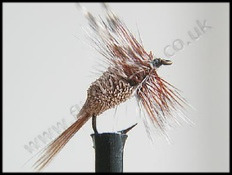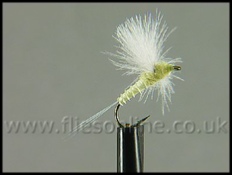EACH PAGE HERE IS AN EXTRACT FROM THE EBOOK.







Dry fly fishing is normally associated with those wonderful summer evenings when
the fish rise to follow the emerging fly life and you try to match the hatch. The
emerger patterns are designed to emulate the fly as it appears at the surface and
has to force its way through the surface tension. Bright days demand the full dressed
flies to compete with the adult that hatches, dries its wings and quickly flies off.
Damper, cooler days will see the emerging fly taking longer to dry their wings and
a fly that sits lower in the water will give better results. Finally, the spinners
(egg layers) and spent (dying) flies require a similarly designed imitation, probably
with open wings and a semi submerged presentation.
In dry fly fishing a fluorocarbon leader will sink in the water very quickly. While
this is a desirable quality in other fishing techniques, it is something to be avoided
in dry fly fishing. The dry fly sits on the water and the fluorocarbon leader sinks,
creating a loop underwater that inhibits the strike when a fish takes. On the other
hand, a monofilament leader will actually float on the meniscus of the water and
this can mean that the fish may be spooked by the leader.
Dry flies, like their name implies are designed to be fished floating on top of the
water. Obviously, therefore, they are fished on a floating line. They should be constructed
of buoyant materials that ensure that they float, such as deer hair - which is hollow,
cul de canard feathers - which have a natural oil content, or even manmade materials
like closed cell foam or Antron. Furthermore, they should be constructed in such
a way that they will float the right way up - the hook should hang in the water and
act like a keel to give ballast and stability to the fly, otherwise they are likely
to be blown off the water by the wind and give an unrealistic silhouette when seen
from below.




















